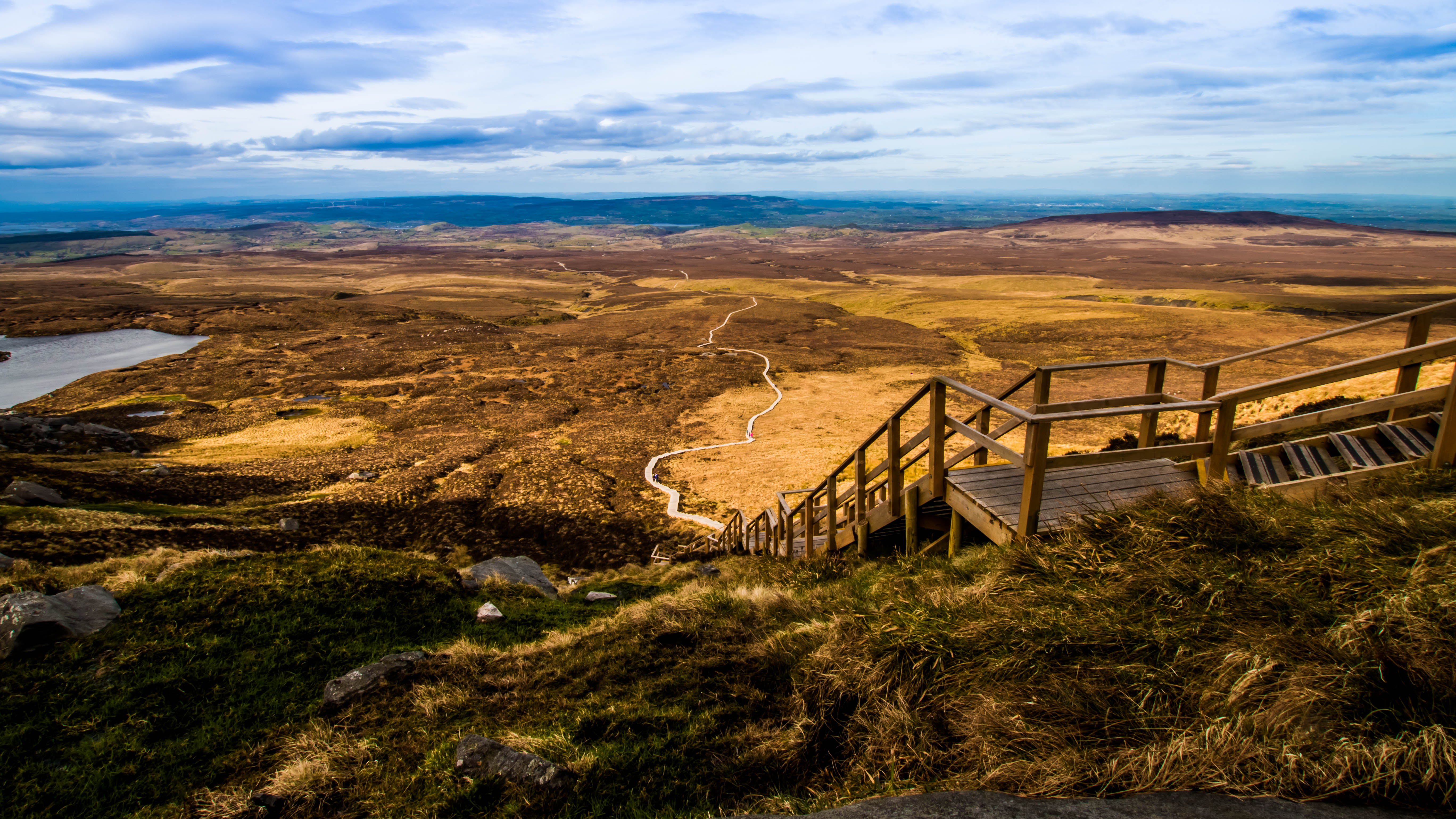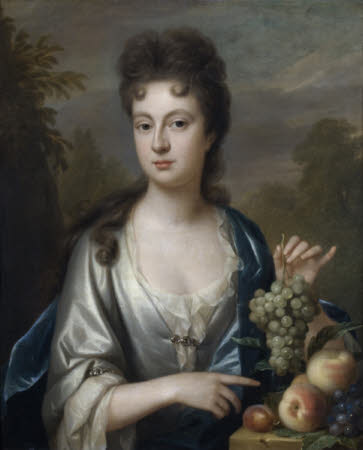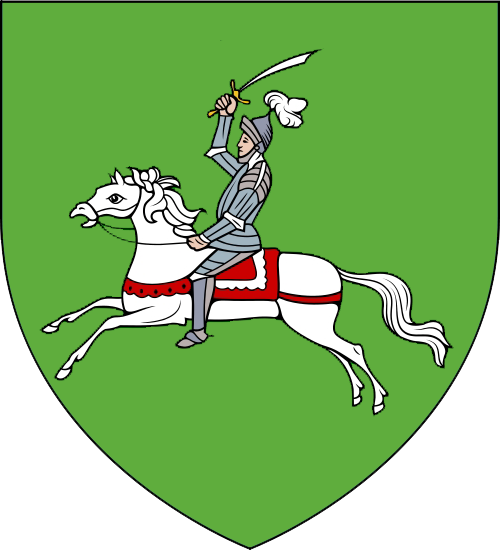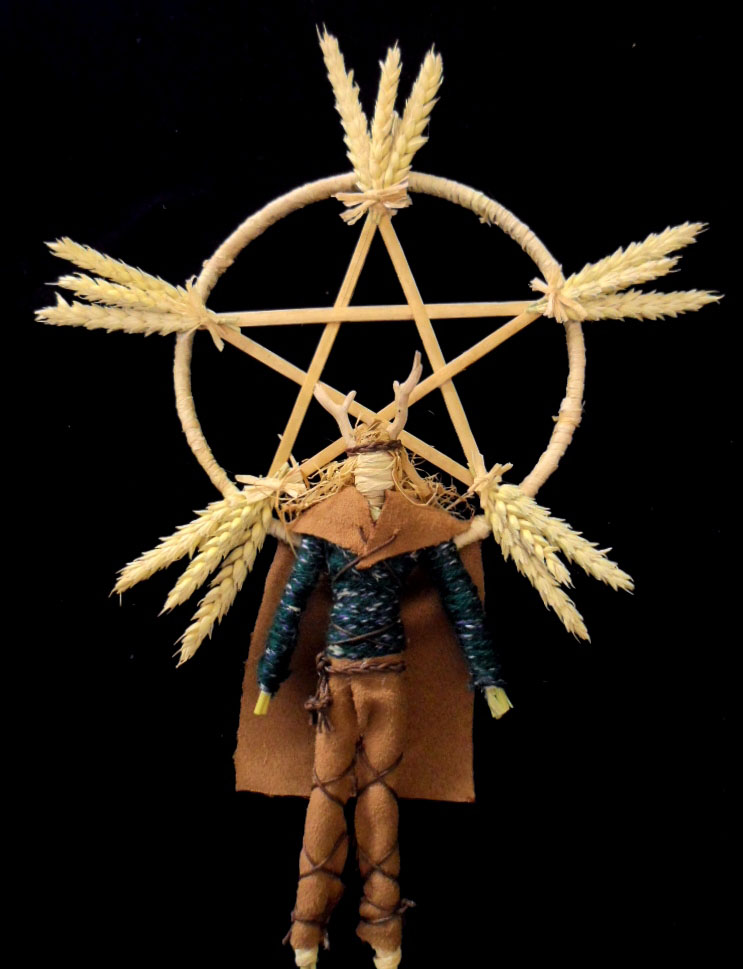|
Benaughlin Mountain
Benaughlin Mountain, or simply Benaughlin (), is a large hill in the Cuilcagh Mountain range in County Fermanagh, Northern Ireland. It rises to above sea level and its composition is mainly of sandstone, limestone and shale. A section of the Ulster Way formerly passed around the side of Benaughlin, within 300 m of the summit until it was revised in 2009 and now instead ascends from Florencecourt. The hill was originally called , which is thought to mean "peak of the speaking horse". Locals would climb the hill on the last Sunday of July for the festival of Lughnasa, and folklore tells of a large white horse () which would appear on the hill each year and speak to them. Benaughlin is also associated with Donn na Binne ("Donn of the peak"), the legendary ancestor of the Mag Uidhir (Maguire) chiefs of Fermanagh and a king of the Sí. He is said to dwell in the mountain, and it was believed that whenever any of his real descendants die, a shard falls off its rocky face. Be ... [...More Info...] [...Related Items...] OR: [Wikipedia] [Google] [Baidu] |
Cuilcagh
Cuilcagh () is a mountain on the border between County Fermanagh (in Northern Ireland) and County Cavan (in the Republic of Ireland). With a height of it is the highest point in both counties. It is also the 170th highest peak on the island of Ireland, and Ireland's only cross-border county top. Water from the southern slope flows underground until it emerges some miles away in the Shannon Pot, the traditional source of the River Shannon. The area is sometimes referred to as the Cuilcagh Mountains. Naming The name Cuilcagh comes from the Irish ''Cuilceach'', which has been translated as "chalky". However, the mountain is mainly sandstone and shale, covered with bog and heather. The cliff-edged summit surface of the mountain is formed from the hard-wearing Lackagh Sandstone which itself overlies the Briscloonagh Sandstone. "It is possible that the name refers to the limestone rock on the lower northern flanks, namely the Glencar and Dartry Limestone formations. Here a number ... [...More Info...] [...Related Items...] OR: [Wikipedia] [Google] [Baidu] |
Donn
In Irish mythology, Donn ("the dark one", from cel-x-proto, Dhuosnos) is an ancestor of the Gaels and is believed to have been a god of the dead. Donn is said to dwell in Tech Duinn (the "house of Donn" or "house of the dark one"), where the souls of the dead gather. He may have originally been an aspect of the Dagda. Folklore about Donn survived into the modern era in parts of Ireland, in which he is said to be a phantom horseman riding a white horse. Early literary sources A 9th-century poem says that Donn's dying wish was that all his descendants would gather at Donn's house or ''Tech Duinn'' (modern Irish ''Teach Duinn'') after death: "To me, to my house, you shall all come after your deaths". The 10th-century tale ''Airne Fíngein'' ("Fíngen's Vigil") says that Tech Duinn is where the souls of the dead gather. In their translation of ''Acallam na Senórach'', Ann Dooley and Harry Roe commented that "to go to the House of Donn in Irish tradition means to die". This suggest ... [...More Info...] [...Related Items...] OR: [Wikipedia] [Google] [Baidu] |
List Of Marilyns In Northern Ireland
This is a list of Marilyn hills and mountains in the United Kingdom, Isle of Man and Ireland by height. Marilyns are defined as peaks with a prominence of or more, regardless of height or any other merit (e.g. topographic isolation, as used in Munros). Thus, Marilyns can be mountains, with a height above , or relatively small hills. there were 2,011 recorded Marilyns. Definition The Marilyn classification was created by Alan Dawson in his 1992 book ''The Relative Hills of Britain''. The name Marilyn was coined by Dawson as a punning contrast to the ''Munro'' classification of Scottish mountains above , but which has no explicit prominence threshold, being homophonous with (Marilyn) '' Monroe''. The list of Marilyns was extended to Ireland by Clem Clements. Marilyn was the first of several subsequent British Isles classifications that rely solely on prominence, including the P600s, the HuMPs, and the TuMPs. Topographic prominence is a more difficult to estimate than t ... [...More Info...] [...Related Items...] OR: [Wikipedia] [Google] [Baidu] |
Peat
Peat (), also known as turf (), is an accumulation of partially decayed vegetation or organic matter. It is unique to natural areas called peatlands, bogs, mires, moors, or muskegs. The peatland ecosystem covers and is the most efficient carbon sink on the planet, because peatland plants capture carbon dioxide (CO2) naturally released from the peat, maintaining an equilibrium. In natural peatlands, the "annual rate of biomass production is greater than the rate of decomposition", but it takes "thousands of years for peatlands to develop the deposits of , which is the average depth of the boreal orthernpeatlands", which store around 415 gigatonnes (Gt) of carbon (about 46 times 2019 global CO2 emissions). Globally, peat stores up to 550 Gt of carbon, 42% of all soil carbon, which exceeds the carbon stored in all other vegetation types, including the world's forests, although it covers just 3% of the land's surface. ''Sphagnum'' moss, also called peat moss, is one of th ... [...More Info...] [...Related Items...] OR: [Wikipedia] [Google] [Baidu] |
Florence Court
Florence Court is a large 18th-century house and estate located 8 miles south-west of Enniskillen, County Fermanagh, Northern Ireland. It is set in the foothills of Cuilcagh Mountain. The nearby village is distinguished by the one-word name Florencecourt. It is owned and managed by the National Trust and is the sister property of nearby Castle Coole. The other National Trust property in County Fermanagh is the Crom Estate. History The history of the building of Florence Court is subject to conjecture and the current house was built in at least two, if not three, phases. The first house on the site was built by John Cole, Esq. (1680–1726) and named after his wife Florence Bourchier Wrey (died 1718). She was the daughter of Sir Bourchier Wrey, 4th Baronet (c. 1653–1696) of Tawstock, Devon. An anonymous history of Fermanagh written in 1718 describes John Cole's house as being 'very costly and sumptuous' but in 1739 Rev. William Henry described this building as being 'but smal ... [...More Info...] [...Related Items...] OR: [Wikipedia] [Google] [Baidu] |
Blanket Bog
Blanket bog or blanket mire, also known as featherbed bog, is an area of peatland, forming where there is a climate of high rainfall and a low level of evapotranspiration, allowing peat to develop not only in wet hollows but over large expanses of undulating ground. The blanketing of the ground with a variable depth of peat gives the habitat type its name. Blanket bogs are found extensively throughout the northern hemisphere - well-studied examples are found in Ireland and Scotland, but vast areas of North American tundra also qualify as blanket bogs. In Europe, the southernmost edge of range of this habitat has been recently mapped in the Cantabrian Mountains, northern Spain, but the current distribution of blanket bogs globally remains unknown. In the southern hemisphere they are less well-developed due to the relatively low latitudes of the main land areas, though similar environments are reported in Patagonia, the Falkland Islands and New Zealand. The blanket bogs known as 'f ... [...More Info...] [...Related Items...] OR: [Wikipedia] [Google] [Baidu] |
King In The Mountain
The king asleep in mountain (D 1960.2 in Stith Thompson's Motif (folkloristics), motif index system) is a prominent folklore Trope (literature), trope found in many folktales and legends. Thompson termed it as the Kyffhäuser type. Some other designations are: king in the mountain, king under the mountain, or sleeping hero. Examples include the legends of King Arthur, Fionn mac Cumhaill, Charlemagne, Ogier the Dane, King David, Frederick Barbarossa at Kyffhäuser, Constantine XI Palaiologos, Prince Marko, Kraljević Marko, Sebastian of Portugal and King Matjaž. The motifs A 571 "Cultural hero asleep in mountain", and E 502, "The Sleeping Army" are similar and can occur in the same tale. A related motif is the "Seven Sleepers" (D 1960.1, also known as the "Rip Van Winkle" motif), whose type tale is the Seven Sleepers of Ephesus (Aarne-Thompson classification system, AT tale type 766). General features King in the mountain stories involve legendary heroes, often accompanied ... [...More Info...] [...Related Items...] OR: [Wikipedia] [Google] [Baidu] |
Aos Sí
' (; older form: ) is the Irish name for a supernatural race in Celtic mythology – spelled ''sìth'' by the Scots, but pronounced the same – comparable to fairies or elves. They are said to descend from either fallen angels or the Tuatha Dé Danann, meaning the "People of Danu", depending on the Abrahamic or pagan tradition. The ''aos sí'' are said to live underground in fairy forts, across the Western sea, or in an invisible world that co-exists with the world of humans. This world is described in the ''Lebor Gabála Érenn'' as a parallel universe in which the ''aos sí'' walk among the living. In modern Irish the people of the mounds are also called ''daoine sí''; in Scottish Gaelic they are called ''daoine sìth'' (in both cases, it means "people of the fairy mound"). They are variously said to be the ancestors, the spirits of nature, or goddesses and gods. Evans Wentz, W. Y. (1966, 1990The Fairy-Faith in Celtic Countries Gerrards Cross, Colin Smythe Humanitie ... [...More Info...] [...Related Items...] OR: [Wikipedia] [Google] [Baidu] |
Fermanagh
Historically, Fermanagh ( ga, Fir Manach), as opposed to the modern County Fermanagh, was a kingdom of Gaelic Ireland, associated geographically with present-day County Fermanagh. ''Fir Manach'' originally referred to a distinct kin group of alleged Laigin origins. The kingdom of Fermanagh was formed in the 10th century, out of the larger kingdom of Uí Chremthainn, which was part of the overkingdom of Airgíalla.MacCotter, Paul. ''Medieval Ireland: territorial, political and economic divisions''. Four Courts Press, 2008, p.243 By the late 11th century it had grown to cover all of what is now County Fermanagh. The kingdom came to be ruled by the Mag Uidhir (Maguire) clan from the late 13th century onward. They were based at Lisnaskea, and their royal inauguration site was nearby Sgiath Gabhra (Skeagoura), now called Cornashee. Under Hugh Maguire, Fermanagh was involved in the Nine Years' War against English rule. His successor, Cú Chonnacht Óg Mag Uidhir, was one of the Gaeli ... [...More Info...] [...Related Items...] OR: [Wikipedia] [Google] [Baidu] |
Maguire
Maguire ( , also spelled MacGuire or McGuire) is an Irish surname from the Gaelic , which is "son of Odhar" meaning "dun", "dark one". According to legend, this relates to the eleventh descendant of Colla da Chrich, great-grandson of Cormac mac Airt, who was monarch of Ireland about the middle of the third century. From the 13th to the 17th centuries, the Maguires were kings of Fermanagh. As a given name, Maguire is uncommon. Naming conventions The surname has been Anglicised variously as Maguire, McGuire and McGwire. History The Maguire sept is primarily associated with modern-day County Fermanagh. They possessed the entire county, also known as Maguire's Country, from about 1250 C.E. and maintained their independence as Lords of Fermanagh down to the reign of King James VI & I, when their country was confiscated like other parts of Ulster. The Maguires supplied Chiefs or Princes to Fermanagh, from about A.D. 1264, when they supplanted the former Chieftains (Ó Daimhín, or ... [...More Info...] [...Related Items...] OR: [Wikipedia] [Google] [Baidu] |
Lughnasa
Lughnasadh or Lughnasa ( , ) is a Gaels, Gaelic festival marking the beginning of the harvest season. Historically, it was widely observed throughout Ireland, Scotland and the Isle of Man. In Modern Irish it is called , in gd, Lùnastal, and in gv, Luanistyn. Traditionally it is held on 1 August, or about halfway between the summer solstice and september equinox, autumn equinox. In recent centuries some of the celebrations have been shifted to the Sunday nearest this date. Lughnasadh is one of the four Gaelic seasonal festivals, along with Samhain, Imbolc and Beltane. It corresponds to other European harvest festivals such as the Welsh and the English Lammas. Lughnasadh is mentioned in some of the Early Irish literature, earliest Irish literature and has Celtic polytheism, pagan origins. The festival itself is named after the god Lugh. It inspired great gatherings that included religious ceremonies, ritual athletic contests (most notably the Tailteann Games (ancient), Tailte ... [...More Info...] [...Related Items...] OR: [Wikipedia] [Google] [Baidu] |
County Fermanagh
County Fermanagh ( ; ) is one of the thirty-two counties of Ireland, one of the nine counties of Ulster and one of the six counties of Northern Ireland. The county covers an area of 1,691 km2 (653 sq mi) and has a population of 61,805 as of 2011. Enniskillen is the county town and largest in both size and population. Fermanagh is one of four counties of Northern Ireland to have a majority of its population from a Catholic background, according to the 2011 census. Geography Fermanagh is situated in the southwest corner of Northern Ireland. It spans an area of 1,851 km2 (715 sq; mi), accounting for 13.2% of the landmass of Northern Ireland. Nearly a third of the county is covered by lakes and waterways, including Upper and Lower Lough Erne and the River Erne. Forests cover 14% of the landmass (42,000 hectares). It is the only county in Northern Ireland that does not border Lough Neagh. The county has three prominent upland areas: * the expansive We ... [...More Info...] [...Related Items...] OR: [Wikipedia] [Google] [Baidu] |

%2C_The_Bull_-_geograph.org.uk_-_284005.jpg)

.jpg)

.jpg)
.jpg)


